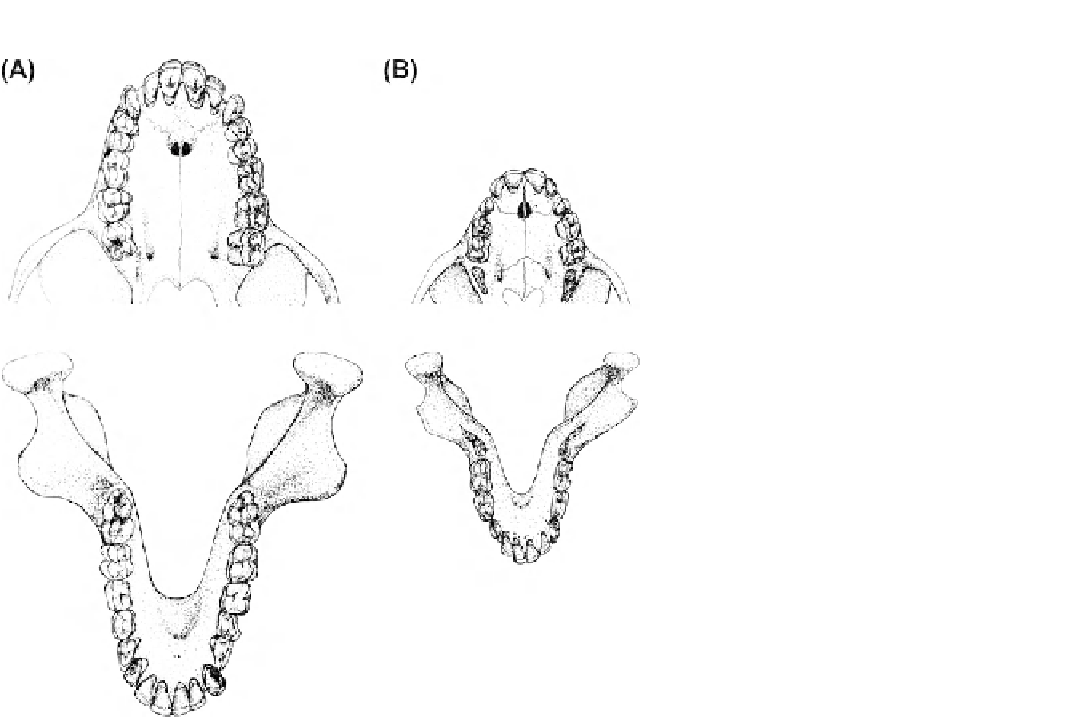Biomedical Engineering Reference
In-Depth Information
FIGURE 4.6
Old World monkey dentition (Macaca
mulatta, female). (A) Permanent dentition (adult);
(B) deciduous dentition (juvenile, age 1.0 year). In the
adult, note the number of premolars in each quadrant,
the diastema between the lateral incisor and the canine,
and the cusp pattern of the molars. In the juvenile, note
the number and cusp pattern of the premolars (called
milk “molars”), the presence of the first permanent
molar in its crypt in each of the four quadrants, and the
relative size of the deciduous teeth as compared to the
permanent
teeth in the adult. (Drawings by Nancy
Hong.)
lateral incisor. The canine tooth is abbreviated C and since
there is only one canine in each quadrant it is written
either C or C1.
Premolars are abbreviated P although Pm or PM are
occasionally encountered in the literature. The numbering
system for premolars is based on studies of the evolutionary
reduction in the number of premolars from the primitive
mammalian number of four. These studies (
Swindler, 2002
)
have shown that premolars are lost from anterior to poste-
rior along the tooth row and that the premolars retained in
living primates are the last of the original premolars. Thus,
the premolars present in living primates are P2, P3, and P4
if the primate species has three premolars and P3 and P4 if
the primate has only two premolars. Use of this system
allows an accurate description and comparison of a specific
tooth regardless of its evolutionary or developmental stage
or the number of premolars present in the species. This type
of designation, however, has not been used consistently by
researchers and clinicians who are unfamiliar with the
evolutionary history of the premolars. Some literature may
therefore incorrectly refer to premolars as P1, P2, and P3
when they should accurately be described as P2, P3, and
P4. The last tooth class in each adult quadrant is the molar
which is abbreviated M. Individual molars are designated
as M1, M2, and M3.
In addition to each tooth in the dental arcade being
designated by a letter and number, the position of the
number for a given tooth is used to indicate the dental arch
in which the tooth appears. If the number is written as
a superscript, the tooth is in the maxillary dental arch. If the
number is a subscript, the tooth is in the mandibular dental
arch. Thus, the first maxillary incisor would be written as I
1
.
Additionally, if the tooth is from the right upper quadrant,
the complete notation would be RI
1
.
Like humans, nonhuman primates have two distinct sets
of dentition (
Figure 4.6
). The first of these, the deciduous or
milk dentition, occupies the same position in the dental
arch as the subsequent successor teeth. A variety of nota-
tions are utilized to indicate that a tooth is deciduous.
Commonly, the letter d appears before the letter indicating
the tooth, although deciduous teeth are sometimes indi-
cated simply using lower typecase (i, c, p or pm, or m)
instead of the capital typecase (I, C, P or PM, or M) used to
indicate permanent teeth. Typically, the deciduous teeth of
each dental quadrant include two incisors, di1 and di2 (or i1
and i2); one canine, dc (or c); and two premolars, dp3 and
dp4 (or pm3 and pm4) in Old World monkeys and apes or
three premolars, dp2, dp3, and dp4 (or pm2, pm3, and pm4)
in New World monkeys. As indicated here the deciduous
cheek teeth are premolars even though they are frequently




